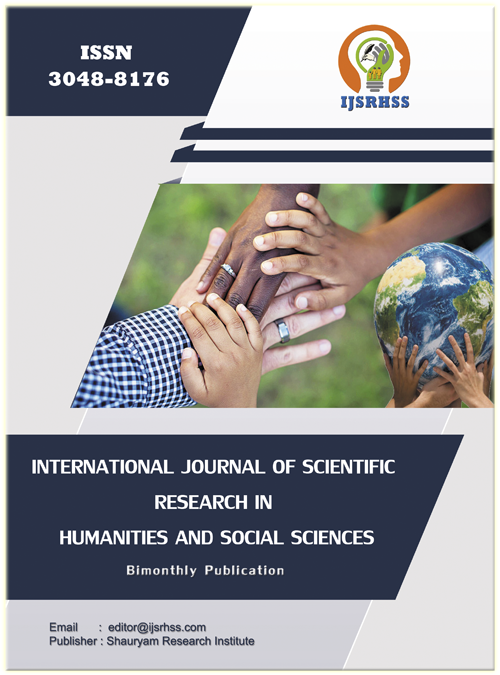Empowering Equality : Exploring the Intersection of Article 39, Socio-economic Rights, and Gender Justice in India
Keywords:
Article 39 Implementation, Gender Equality, Women’s Labor, Stereotyping, SocietyAbstract
This study delves into the transformative potential of Article 39 of the Directive Principles of State Policy (DPSP) in the Indian Constitution, focusing on its role in bridging socio-economic disparities and advancing gender justice. Enshrined within Part IV of the Constitution, Article 39 mandates the state to ensure that men and women equally have the right to an adequate means of livelihood, and that economic power is not concentrated in the hands of a few, among other social objectives. By critically analyzing legal developments, public policy interventions, and landmark judicial pronouncements, the paper explores how Article 39 serves not merely as a moral guideline but as a constitutional commitment to substantive equality (Austin, 1999; Basu, 2021).
The research highlights the intersectionality between socio-economic rights and gender equality, particularly in the realms of employment, property rights, access to healthcare, and education. The implementation of schemes like Mahatma Gandhi National Rural Employment Guarantee Act (MGNREGA) and Beti Bachao Beti Padhao are examined as practical expressions of Article 39’s egalitarian ethos (Muralidhar, 2004; Pathak, 2014). Furthermore, judicial activism—especially the progressive interpretations in cases like Air India v. Nargesh Meerza and Vishaka v. State of Rajasthan—demonstrates how courts have operationalized Article 39 in alignment with Articles 14 and 15, thereby reinforcing constitutional gender parity (Sathe, 2002; Bhatia, 2019).
Through a socio-legal lens, the paper argues that despite being non-justiciable, Article 39 functions as a normative foundation for India’s social justice framework. The study concludes that while notable strides have been made, the full realization of Article 39’s gender justice promises remains contingent on greater political will, inclusive policy-making, and grassroots mobilization. Hence, Article 39 continues to act as a beacon for constitutional morality and democratic transformation in contemporary India (Rajagopal, 2003; De, 2011).
In the Indian context, gender inequality is deeply embedded within the socio-economic fabric, often manifesting through wage gaps, unpaid care work, unequal access to education, and underrepresentation in decision-making bodies. Article 39, especially clauses (a), (d), and (e), explicitly aim to rectify these disparities by ensuring equal pay for equal work and by preventing the exploitation of women and children. This paper argues that these principles, though non-enforceable by courts, have significantly influenced the trajectory of India’s welfare state and gender-responsive governance (Baxi, 2008; Chandrachud, 2017).
The discussion further analyzes the interplay between Article 39 and Article 15(3)—which allows the State to make special provisions for women and children—revealing a constitutional synergy that lays the groundwork for positive discrimination and affirmative action. For instance, government initiatives such as Janani Suraksha Yojana, POSHAN Abhiyaan, and the Sexual Harassment of Women at Workplace Act, 2013, align with Article 39’s vision of empowering women through targeted socio-economic protections and workplace dignity (Jayal, 2013; Muralidhar, 2004).
The research also addresses the gendered dimensions of economic policy, emphasizing the need for a gender budgeting framework that aligns with the moral compass provided by Article 39. While feminist economists have pointed out the invisibilization of women’s labor in macroeconomic planning, Article 39 offers a normative counterpoint that can anchor gender-inclusive economic reforms (Rajagopal, 2003; Pathak, 2014).
Importantly, the role of civil society movements and judicial sensitization is highlighted as crucial in translating constitutional morality into actionable gender justice. Landmark judgments such as Indira Sawhney v. Union of India and Joseph Shine v. Union of India reflect the judiciary’s growing recognition of intersectional inequalities, further substantiating the living spirit of Article 39 (Sathe, 2002; Bhatia, 2019).
Downloads
References
Austin, G. (1999). Working a democratic constitution: The Indian experience. Oxford University Press.
Basu, D. D. (2021). Introduction to the Constitution of India (24th ed.). LexisNexis Butterworths.
Baxi, U. (2008). The future of human rights (3rd ed.). Oxford University Press.
Bhatia, G. (2019). The transformative constitution: A radical biography in nine acts. HarperCollins India.
Chakravarti, U. (2003). Gendering caste: Through a feminist lens. Stree.
Chandrachud, A. (2017). Due process of law: A comparative study. Oxford University Press.
Deshpande, A. (2020). Affirmative action, the state, and minorities in India. In A. J. Wilson (Ed.), Politics of inequality (pp. 94–113). Sage.
De, R. (2011). The constitutional history of India. Penguin Books.
Ghosh, S. (2015). Economic rights and constitutionalism in India. Oxford University Press.
Jaising, I. (2005). Bringing rights home: Review of implementation of CEDAW. Economic and Political Weekly, 40(18), 1939–1944.
Jayal, N. G. (2013). Citizenship and its discontents: An Indian history. Harvard University Press.
Khaitan, T. (2015). A theory of discrimination law. Oxford University Press.
Muralidhar, S. (2004). Law, poverty, and legal aid: Access to criminal justice. LexisNexis.
Narain, V. (2008). Gender and constitutional design. Journal of Gender Studies, 17(1), 47–61.
Pathak, A. (2014). Contesting development: Critical struggles for social change. Routledge.
Rajagopal, B. (2003). International law from below: Development, social movements and Third World resistance. Cambridge University Press.
Downloads
Published
Issue
Section
License
Copyright (c) 2024 International Journal of Scientific Research in Humanities and Social Sciences

This work is licensed under a Creative Commons Attribution 4.0 International License.




